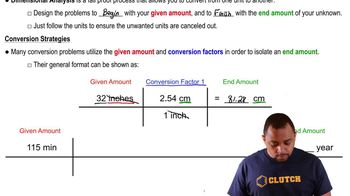Here are the essential concepts you must grasp in order to answer the question correctly.
Unit Conversion
Unit conversion is the process of converting a quantity expressed in one set of units to another set of units. This involves using conversion factors, which are ratios that express how many of one unit are equivalent to another. For example, to convert from millimeters per second to kilometers per hour, one must know the relationships between these units, such as 1 km = 1,000 m and 1 hour = 3,600 seconds.
Recommended video:
Density and Mass-Volume Relationships
Density is defined as mass per unit volume and is typically expressed in units such as grams per milliliter (g/mL) or pounds per cubic foot (lb/ft³). Understanding density is crucial for converting between mass and volume measurements, as it allows for the calculation of how much mass is contained in a given volume of a substance. For instance, knowing the density of a material can help convert its weight in lb/ft³ to its equivalent in g/mL.
Recommended video:
Dimensional Analysis
Dimensional analysis is a mathematical technique used to convert units by treating the units as algebraic quantities. This method involves multiplying the original measurement by conversion factors that cancel out the unwanted units, leaving the desired units. It is a systematic approach that ensures accuracy in conversions and helps verify that the final answer is dimensionally consistent.
Recommended video:
 Verified step by step guidance
Verified step by step guidance


